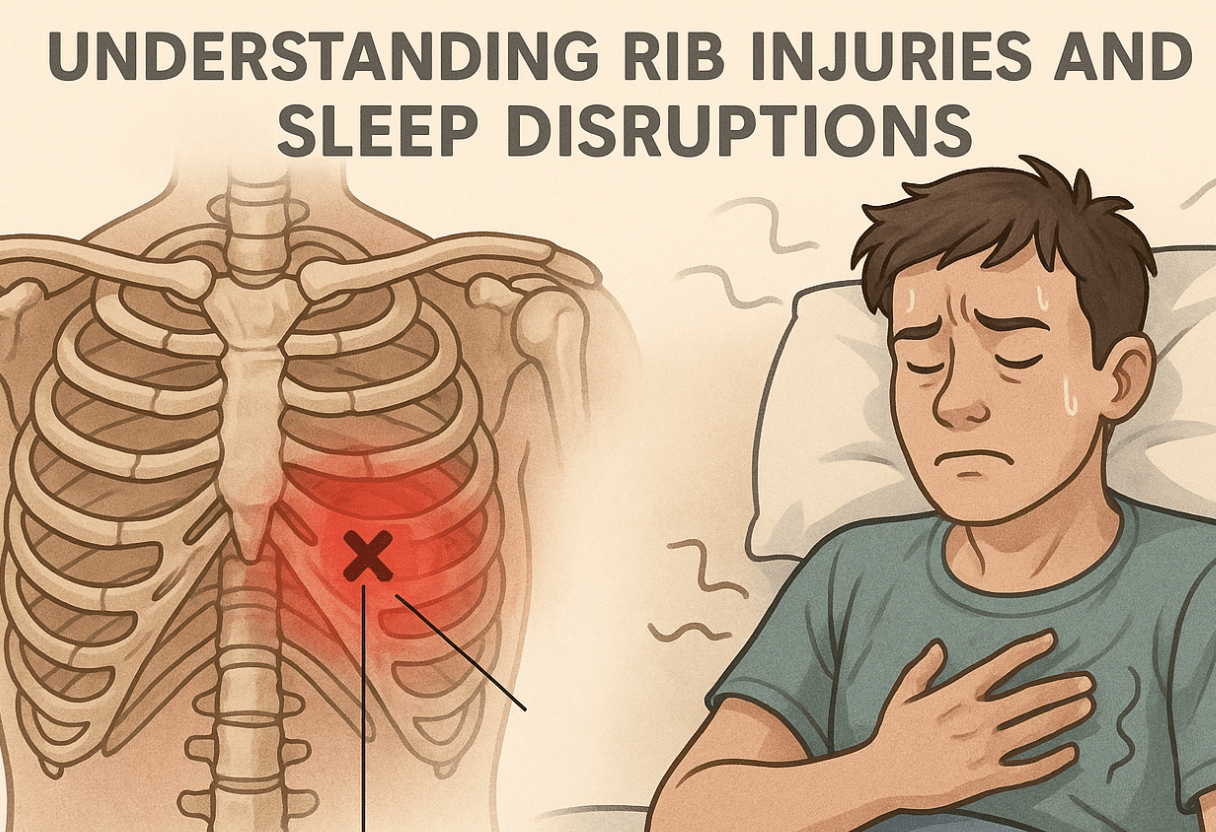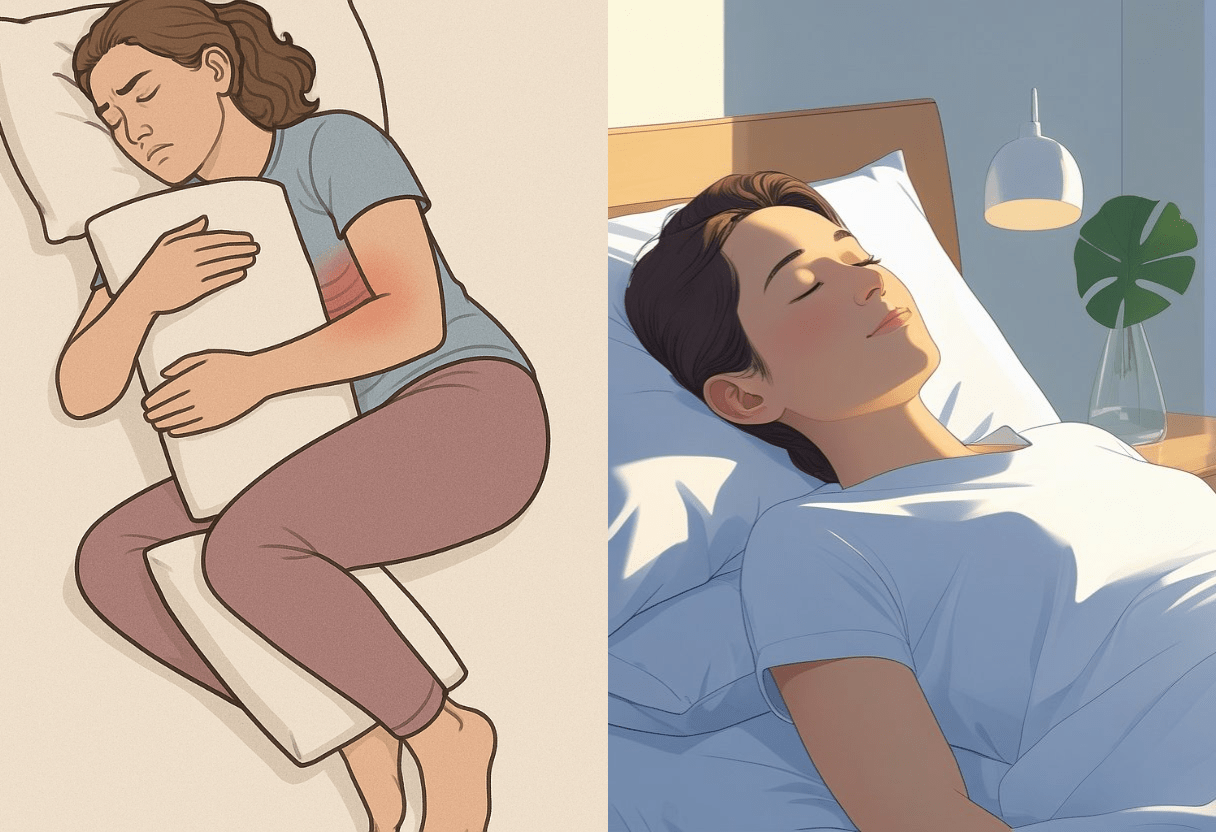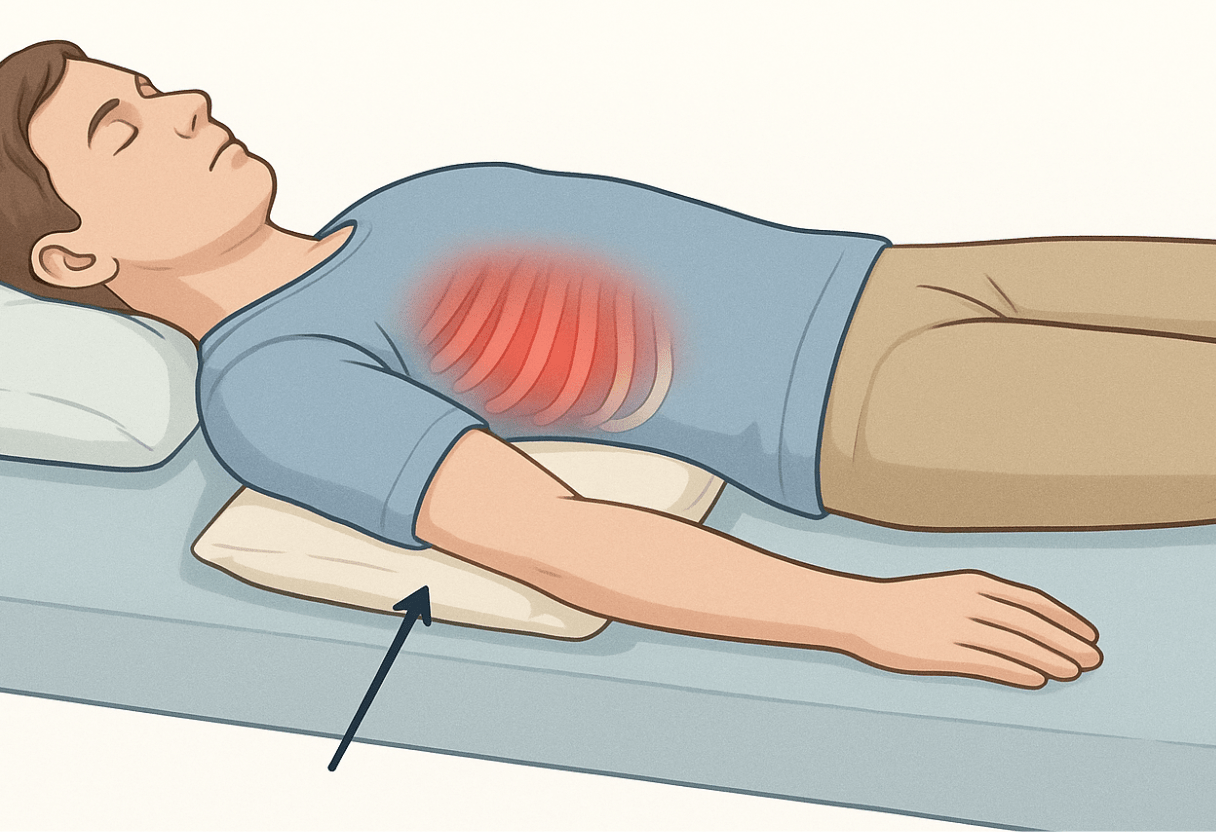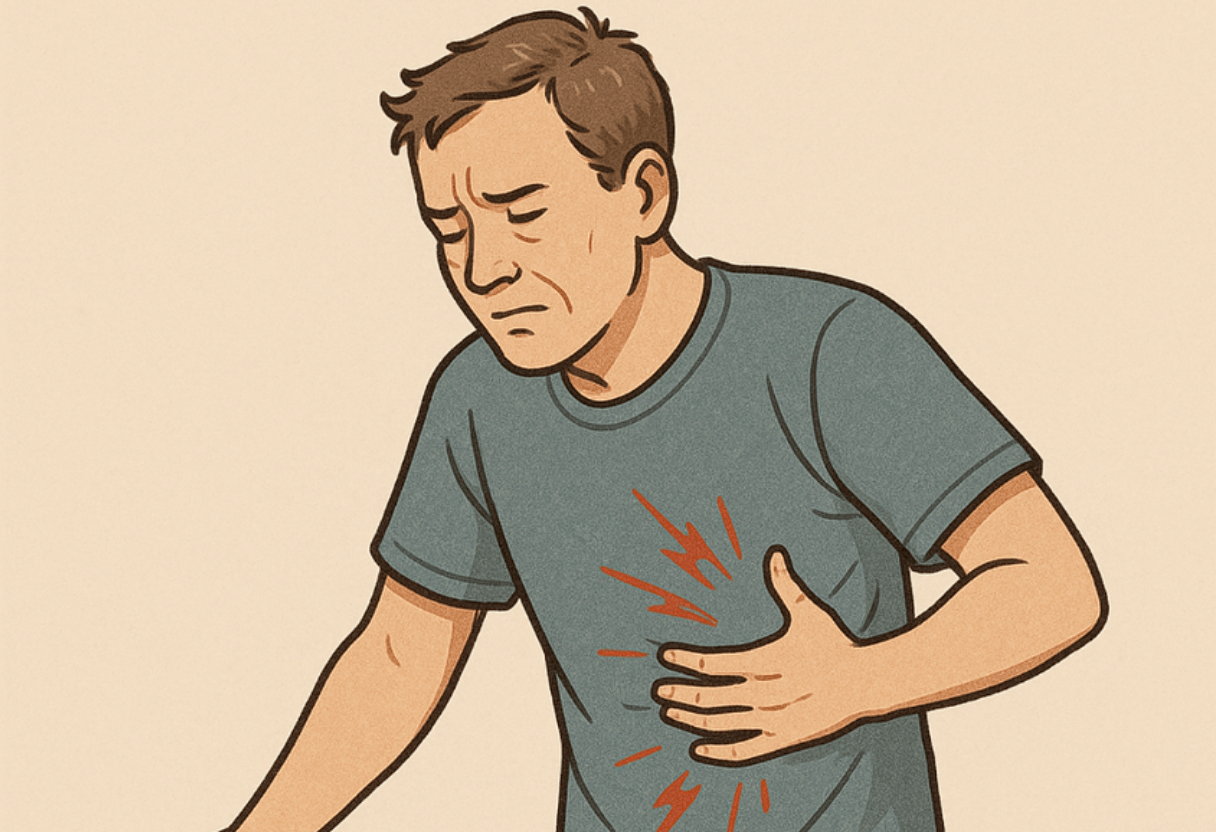Sleeping with broken ribs can be uncomfortable and finding a good position is often hard. It helps to keep the upper body elevated, either by reclining or sitting up. This position reduces pressure on the ribs and makes breathing easier. Sleeping upright also lowers the risk of rolling onto the injured side. Using pillows to support the body and limit movement can ease discomfort. Some people sleep best on their back with a slight incline or in a recliner chair rather than flat. Taking pain medicine before bed and moving carefully when getting in or out of bed can also make sleep less painful and help with recovery.
People with fractured ribs need to adjust their sleeping space and habits to protect the injury. Simple supports and proper positioning can make a noticeable difference in comfort and healing. A medium hybrid mattress can provide balanced support, relieve pressure, and help keep the body aligned, which reduces strain on broken ribs and improves sleep quality.
Key Takeaways
- Raising the upper body reduces pain and makes breathing easier.
- Pillows and stable positions prevent harmful movements while asleep.
- Pain control and careful bed movements support healing.
- A medium hybrid mattress provides support, pressure relief, and better alignment for broken ribs.

Understanding Rib Injuries and Sleep Disruptions

Rib injuries may lead to severe pain and influence sleep. The nature of the injury alters the feeling of discomfort and influences healing. Having the right sleeping position is necessary to prevent pain and facilitate recovery.
Variations in Broken, Bruised, and Fractured Ribs
A broken rib means the bone is cracked or split in two. This often causes sharp pain, especially when taking a deep breath or moving. Bruised ribs affect the muscles and tissues around the ribs without breaking the bone. The pain is usually milder than with broken ribs but can still hurt when you touch or move the area. Fractured ribs are another way to say broken ribs. The crack may be partial or complete, and the pain can last longer than with a bruise. Each type of injury needs slightly different care to reduce night pain and prevent further damage.
Why It’s Hard to Sleep with Rib Injuries
Sleeping is tough because any pressure on the ribs can hurt. Lying on the sore side or turning in bed often makes the pain worse. Breathing moves the rib cage, which can increase discomfort for broken or fractured ribs. It becomes hard to find a comfortable position that eases the pain. People with rib injuries may take shallow breaths to avoid pain. But this can lower oxygen levels and slow healing. The body naturally shifts during sleep, so staying still is difficult when the ribs hurt.
How Rib Injuries Affect Healing During Sleep
Sleep helps the body repair bones and muscles. Hormones that aid tissue repair and reduce inflammation increase during rest. Pain from ribs can interrupt this process. Pain often causes waking or restlessness, reducing deep, restorative sleep. This can slow recovery. Using the right sleeping positions can put less pressure on the ribs and help with breathing. Pillows can support the body and keep it more comfortable. Learning how to sleep safely with bruised or broken ribs helps protect the area and speeds up healing.
Best Sleeping Positions for Broken Ribs
Ensuring proper sleeping with fractured ribs is most important in preventing pain and promoting healing. Some sleeping positions minimize rib pressure and facilitate breathing. Other sleeping positions maximize discomfort and should be avoided.
Upright and Semi-Upright Sleeping
Sitting up or leaning slightly back puts less pressure on broken ribs and makes breathing easier. Using a wedge pillow or reclining in a chair at 30 to 45 degrees can relieve pain and keep the chest from feeling tight. This position supports the ribcage better than lying flat. It also lowers the chance of sharp pain when taking deep breaths. Keeping the neck and lower back aligned with extra pillows helps reduce strain. For those with a broken sternum or separation at the cartilage, sitting up like this can protect the front of the chest from extra stress.
Side Sleeping Versus Back Sleeping
Side sleeping is the most comfortable for people with broken ribs. Placing a firm pillow between the knees and another around the chest stabilizes the body and reduces painful movement. It also keeps weight off the injured ribs. But not every rib injury is the same. If one side is broken, lying on the opposite side is safer and protects the injured area.
Sleeping on the back can work if the upper body is slightly elevated. Lying completely flat can cause pressure and pain as the chest moves during breathing. Elevation helps ease pressure and keeps pain manageable.
Positions to Avoid With Rib Injuries
Sleeping on the stomach or flat on the floor should be avoided. Both put pressure on the ribs and make breathing painful. Heavy blankets or tight bedding can press on the injured ribs and make discomfort worse. Sudden twisting or turning in bed may also slow healing. Curling tightly into a fetal position is not recommended. It limits chest expansion and increases rib pain. Choosing supportive positions and limiting movement can control pain and help recovery.

Using Pillows and Sleep Accessories
With the right pillows and accessories, pressure on broken ribs can be minimized and a favorable position can be maintained during the night. Support avoids much movement and pain and improves quality of sleep during recovery.
Wedge Pillows for Support
A wedge pillow for fractured ribs lifts the upper body to reduce pressure on the ribcage. This position makes breathing easier and limits twisting or reclining, which can cause more pain.
The pillow should be firm enough to keep its shape but soft enough to be comfortable. Usually, a 30-45 degree angle works best. Many people find a wedge pillow better than stacking regular pillows because it keeps the body evenly supported through the night. It can also help reduce acid reflux that happens when lying flat. For multiple broken ribs, a wedge pillow often provides the most consistent support and relief from discomfort.
Strategic Pillow Placements for Comfort
Placing pillows around the body can protect broken ribs and support key areas. Common positions include:
- Under the painful side when lying on your back to reduce pressure
- Between the knees when sleeping on your side to keep the hips aligned
- Under the arms to support the upper body and prevent twisting
Using a soft but firm pillow designed for broken ribs cushions the area and reduces impact from movement. Proper placement keeps the ribs stable and helps reduce pain during the night.
Mattress and Bedding Factors
The right mattress and bedding are great for broken ribs. A mattress that’s too firm can increase pain, while one that’s too soft won’t give enough support. Memory foam or hybrid mattresses usually relieve pressure along the ribcage. Adding a mattress topper can give extra cushion without losing support.
Light, breathable bedding is better for sensitive skin and ribs. Heavy blankets can press on the ribs and make moving uncomfortable. Soft comforters and thin sheets usually work best to stay comfortable while recovering. Replacing pillows and adjusting bedding can help create a better sleeping setup for healing broken ribs.

Pain Management Strategies Before Bedtime
Pain control before bedtime is important for anyone with broken ribs. Using medication correctly, applying heat or cold, and practicing relaxation can reduce discomfort and make breathing easier.
Timing and Types of Medication
Taking pain medicine 30 to 60 minutes before bed helps it work as you fall asleep. Over-the-counter options like ibuprofen or acetaminophen can ease pain and swelling. Stronger painkillers may be prescribed for more severe pain. Follow dosage instructions carefully to avoid side effects.
Some people use a mix of medications for better control. Taking them regularly during the day, not just at night, can prevent pain from getting worse. Always check with a doctor before changing your medication routine.
Heat and Cold Therapy Applications
Cold packs work well for the first 48 hours to reduce swelling and numb pain. Wrap ice in a cloth to protect the skin. After swelling goes down, heat can help relax muscles and improve blood flow. Use heat pads for no more than 20 minutes at a time to avoid burns. Some people switch between cold and heat for relief. Avoid applying either while sleeping, as it can be unsafe or uncomfortable.
Breathing and Relaxation Techniques
Pain may make you take shallow breaths, which can increase discomfort or cause lung problems. Slow, deep breaths help expand the lungs gradually. An incentive spirometer can also help improve lung movement.
Relaxation exercises like guided meditation, gentle stretches, or muscle relaxation before bed can reduce tension and make pain more manageable. Staying calm and focusing on steady breathing helps the body prepare for sleep even with discomfort.

Safe Movement and Bed Transitions

Careful movement is necessary to prevent additional pain or injury when having fractured ribs. Controlled and light movements, as well as positioning support, assist in shielding the ribs in transition to the bed. Proper attire also assists in keeping the body at ease and reducing friction in the region of the injury.
Getting Into Bed With Rib Injuries
When getting into bed, avoid sudden or twisting movements. Sit on the edge of the bed first to manage motion and keep pressure off the bruised ribs. Position your uninjured side closest to the mattress and use one hand to support yourself on the bed. Holding a pillow against the injured ribs helps cushion and protect them. Gradually lie down on the uninjured side with knees bent for stability. Then swing your legs onto the bed and, if comfortable, slowly turn onto your back. These steps reduce stress on the ribs and prevent sharp pain.
How to Get Out of Bed With Broken Ribs
Getting out of bed should be slow and controlled. The log roll method works well. First, roll onto your side on the uninjured ribs, hugging a pillow to protect the injured area. Next, swing your legs over the edge of the bed and use your arms to push into a sitting position. Moving carefully prevents extra pressure on the chest or muscle strain. Avoid sitting upright without support, as this can pull on the ribs and increase pain. Placing pillows behind the ribs makes movement easier and more comfortable.
Comfortable Attire
Loose, soft clothing helps avoid irritation on broken ribs. Tight or compressive garments can press on the area and worsen pain during movement or breathing. Clothes made of cotton or other soft fabrics are best. Front-opening or wide-neck tops make it easier to change positions or use ice packs and other pain relief.
Avoid tight bandages or compression wraps. They can limit breathing and increase the risk of lung problems. Comfortable clothing allows smoother movement in bed and keeps the ribs from being overly constrained.
Adaptations for Special Rib Injury Cases
Rib injuries can make sleeping painful, so you need to adjust how you rest. Good support and positioning help ease pain and make breathing easier. This also helps your body heal more comfortably.
Sleeping With Costochondral Separation
Costochondral separation happens where the ribs connect to cartilage. It can cause sharp pain when you breathe or move. Sleeping slightly upright can reduce pressure on that area. Try using a few pillows or a recliner to keep your upper body raised. Avoid lying flat or on the injured side, since that can make pain worse. If you roll over, put a soft pillow against the ribs to protect them. Doing gentle breathing exercises at night can help your lungs expand without causing more pain.
Sleeping With Broken Sternum
A broken sternum hurts in the center of the chest and makes moving hard. Lying on your back with the upper body slightly elevated usually feels best. Place pillows under your head and shoulders for a gentle incline. Don’t sleep on your side or stomach because it can worsen the injury. Wrapping a pillow around your body can give extra support and prevent sudden movements. Talk to your doctor about pain relief to make sleep easier and avoid breathing issues.
Mattress Tips for Sleeping Comfortably with Broken Ribs
The appropriate mattress can significantly enhance comfort for a person with fractured ribs. A mattress that offers enough support without being too soft or too firm helps keep the body aligned. This can reduce pressure on the injured ribs and make resting easier.
A medium mattress often works best because it balances support and comfort. It stops the body from sinking too much while still cushioning the rib area. Hybrid mattresses, which combine support coils with soft foam layers, can provide both stability and gentle pressure relief. This combination makes them a solid choice for recovery.
Pillows can be placed around the body to limit movement and protect the ribs. The Helix Midnight mattress, for example, offers a medium feel with pressure-relieving foam and zoned support. It keeps the body aligned and comfortable. It also has extra lumbar support and breathable foam layers that help with ventilation and cooling. This setup can ease pressure on sensitive areas and keep someone comfortable during long recovery periods.

Frequently Asked Questions
Sleeping with broken ribs can be very painful, and finding a comfortable position is hard. Supporting your body and being careful with movements helps reduce pain and can speed up healing.







